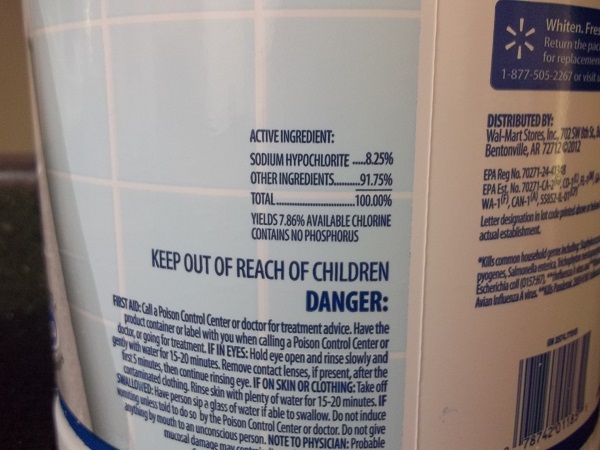If you want to know how to purify water with the “new” bleach, you’ve come to the right place….
I was at Walmart the other day and remembered that I needed a new bottle of bleach and apparently it’s been a while because every bottle I looked at said “More Concentrated” on the label. I mean EVERY bottle, even the generic bleach! Here’s what they say:

Granted, I didn’t thoroughly scour every bottle on the shelf because my better half was in a slight hurry but I swear they all said “more concentrated.” I thought to myself: What the heck!? Where’s the normal bleach? You know, the stuff that says 5.25% sodium hypochlorite. Instead, they all say 8.25% sodium hypochlorite, like this:
Now, it’s been a while since I’ve done basic math but 8.25% is a lot more than 33% greater than 5.25% (it’s 57% if you want to know) which means at some point in the (recent?) past bleach has gotten stronger and I wasn’t fully aware of it. I do know the concentrated bleach I’m accustomed to was generally 6-6.25% which is in line with the 33% “more concentrated” statements so that must be the base number they’re working off of. Anyway, the entire point here is to tell you that the dosing charts and information that floats around the Net about proper use of bleach to disinfect water are no longer pertinent to this newer “more concentrated” 8.25% bleach.
The Generally Accepted Ratios on How to Purify Water Using 5.25% Bleach
- 2 drops per quart of water
- 8 drops per gallon of water
- 1/2 teaspoon per 5 gallons of water
If water is cloudy (or doesn’t have a very slight smell of bleach) then you can double the dosage. In other words, you can use up to 4 drops per quart, 16 drops per gallon, and 1 teaspoon per 5 gallons. That said, you shouldn’t continue to dose it beyond a second round. Remember, that bleach is still a chemical and is only useful as a short-term water treatment option. Also, I believe the above recommended doses work for the 6-6.25% bleach as well.
My Revised Ratios on How to Purify Water Using 8.25% Bleach
Like I mentioned above, the “more concentrated’ bleach is 57% more concentrated than the original 5.25% bleach. Also considering that the numbers above also work for the 6-6.25% bleach as well, this makes it slightly difficult to make exact conversions but we’ll do our best. A few notes before getting to the guidelines:
- Drops (from a dropper) are hard to measure and vary widely. Searching the web for “how many drops in a teaspoon” and the answers are all over the place, ranging from 50-120 and obviously depends on how large the dropper opening is. The best bet is to do some actual real-world testing at home with the dropper you intend to use. That is, count the number of drops needed to fill 1 teaspoon and you’ll know for sure. Then write it down! In my own tests of three different droppers I found that I needed between 80-100 drops to equal a teaspoon. I’ll take the average and assume 90 drops per teaspoon below.
- If you’re going to dose water with bleach I feel you’re better off dosing larger quantities so that you can use teaspoons instead of droppers to help minimize dropper variances but if you insist on using droppers then you really need to know how many drops from your dropper equal a teaspoon.
The guidelines on how to purify water with bleach (the following assumes 90 drops per teaspoon as per my own testing):
- 1+ (but not more than 2) drops per quart of water. You actually need about 1.25 drops per quart of water according to the conversion at 90 drops per teaspoon. I might still use two drops per quart and call it good–due to dropper variances–but no more than that.
- 5-6 drops per gallon of water. 5 drops is roughly the same as 1/18 of a teaspoon (according to my teaspoon conversion from above) if you can measure that small. I can’t.
- 1/3 teaspoon per 5 gallons of water. 1/3 of a teaspoon is hard to measure and 1/4 teaspoon is too little bleach. You could either approximate with a “heaping” 1/4 teaspoon or a “short” 1/2 teaspoon… or, better yet, use more/less water so that 1/4 or 1/2 teaspoon makes sense. To help you out, you would need 4 gallons per 1/4 teaspoon of bleach and 7.8 gallons per 1/2 teaspoon of bleach. I wouldn’t have a heart attack if you rounded the latter up to 8 gallons but that choice is up to you.
- 1 teaspoon per 15 gallons of water. This is just slightly over the actual necessary amount (you actually need 0.955 tsp).
- 2 teaspoons per 30 gallons of water. 30 gallon water barrels are a common water storage option.
- 1 tablespoon + 2/3 teaspoon per 55 gallons of water. 55 gallon water barrels are another common water storage option.
- 6 tablespoons per 270 gallons of water. IBC totes often come in 270 gallon sizes.
- 7 tablespoon + 1 teaspoon per 330 gallons of water. IBC totes often come in 330 gallons sizes.
Again, the advice above on how to purify water is basic math–hopefully I didn’t mess any of that up–but not 100% cut and dry either, especially where small quantities of water and drops are involved. That said, I hope it helps you get your dosing right with the newer “more concentrated” bleach!


Leave a Reply